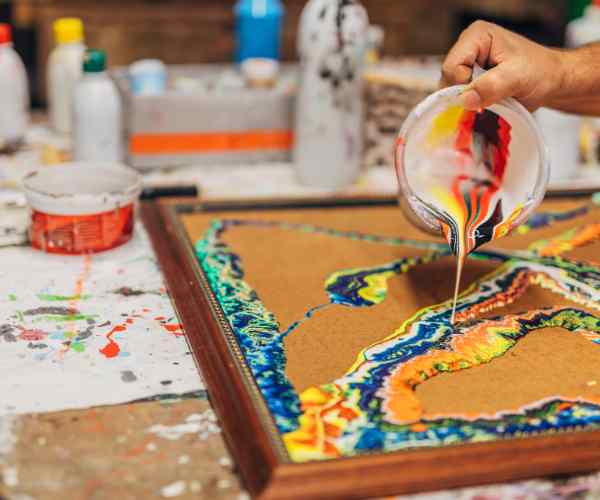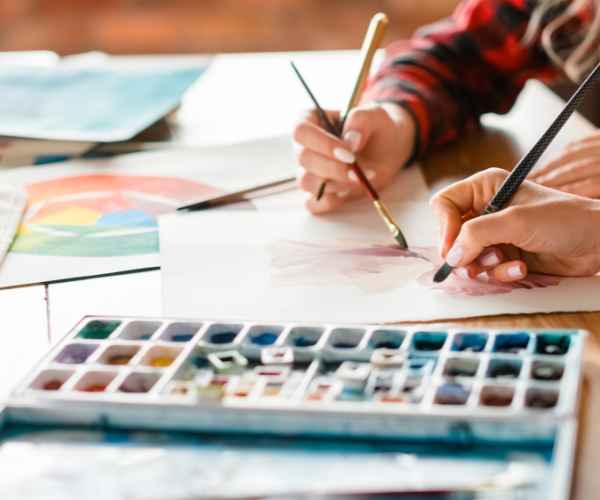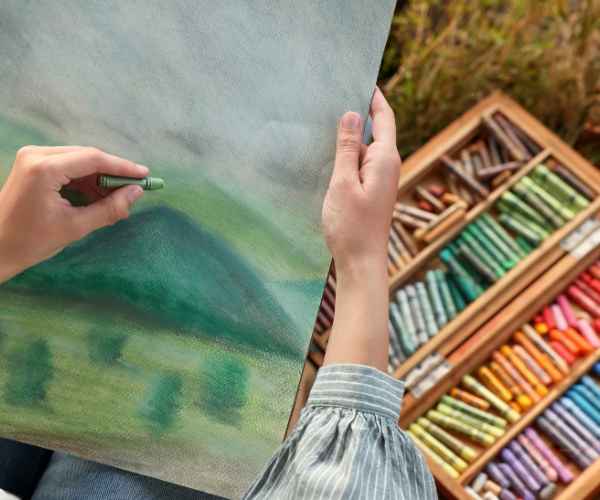If you’ve ever admired a canvas that resembles a whirlpool of color, then you’ve come across the professional art technique called acrylic pour painting. This style of art has gone viral in the art community, and rightfully so! Acrylic pour painting makes it possible for the inexperienced and even a seasoned artist to unleash their imagination on an infinite canvas. With a fraction of the required tools and a desire to create, stunning pieces of artwork which match your personality and love for art can be created. In this post, I’m thrilled to include a detailed and well-thought-out tutorial to immediately get you started on your journey into the wonderful world of pour art. From what types of acrylics to use, and everything else you need to know if you’re ready to start your journey into this colourful and beautiful new world. And the most exciting thing about this is that there is no limit! Think about it – adding an accent piece to your home decor using a canvas to match the vibrant living room or creating a unique, handcrafted gift for a close friend. Are you ready to dive in? Let’s start this adventure of discovering the art of acrylic pouring!

What is acrylic pouring?
So, what tits and bits are involved with pouring acrylic?
In its simplest form, it involves mixing pouring acrylic paint with a pouring medium and pouring it onto a canvas.
As paint is poured onto the canvas, and as paint is poured on top of paint, the interaction creates stunning visual effects ranging from smooth flow to rigorous shapes.
I remember the first time I saw it; I was ready to jump straight in! Seeing the colors meld together and shift felt as if I witnessed a creative mini-explosive war!!
What I love the most about pour painting is its easiness.
You don’t have to be a pro painter to make something even.
Be it a first timer who wants to have a taste of painting or an experienced fluid artist seeking a credible means to express one’s creativity, acrylic pouring has gots it all.
You can play around with colors and try different pouring techniques to make something interesting and this is the best part, you have fun while doing it!
Necessary Tools for Acrylic Pouring
Alright now since we have a pretty good understanding of what is pouring acrylic, lets not wasting any more time and get straight into the necessary materials you would want to pick up to get started.
Here we have a quick list of things to spare:
The repotting colors: Colors should always be more in quantity so that variety can be increased. Do not be scared to try combinations of different colors! You never know what You might like best.
The pouring medium: I oil firmly use Floetrol or silicone oil which can produce those beautiful cells you might have seen in other pour paintings, this helps in achieving proper density.
The pour cups and funnel: These are great tools to keep to blend and pour paint. I always keep a few extras on hand as well – things can become pretty difficult!
The canvas: Depending on your style to fit the space, find the best suited size. I prefer to utilize a variety of dimensions in order to create distinctive wall hangings.
Gesso: I consider using gesso as a special coat which is only made in gesso. This was a lesson that I was taught at an early stage. This enables the paint to adhere to the canvas better and can also give a more even surface.
A few pointed tips would be to Whenever preparing your list of materials, don’t be afraid to shell out a little for quality.
There is no denying the impact on your final piece!
Considerations of Safety
But of course, before you begin pouring, let us discuss how best to keep safe.
Because pouring paints with acrylics can be very exciting, safety is critical to remember.
To start with also, ensure that there is enough fresh air like outside.
I have learned this the hard way, during mixing of pouring medium, the fumes tend to be a bit too much. Always observe proper fume precautions.
I would also advocate for the use of a mask and a glove when in contact with certain chemicals like silicone.
There is nothing wrong in being more careful than less careful.
A small foresight into such situations enhances the acrylic pouring experience for the individual. As such the experience will be not only fun, but safe too.
Step one: Preparing your workspace
Having discussed the basic requirements, we now need to move onto our workspace preparation.
A well-organized workspace is equally important and is an absolute requirement in getting a good pour.
I set up all supplies first as this prevents mess and distraction of reaching for things. I always have my supplies in easy to reach positions.
Place plastic or old newspapers on surfaces to cover them. You don’t want to be washing paint off the dining table after the pouring!
Lastly, placing drop cloths on the floor will help minimize mess caused by accidental drips.
I’ve had a few paint puddles sneak over to the floor, and let’s just say removing them proves to be a challenge!
Mixing Your Paints
At long last, let’s go over the enjoyable segment – mixing your paints!
This particular step is of utmost importance as it aids in ensuring that the perfect flow in your paint is achieved and it appears beautiful, regal and stunning on the canvas.
An advice worth giving out would be to take the ratio of 1 part paint to 2 parts pouring medium.
I know this ratio is a bit strict, however, it is more flexible in terms of the particular acrylic paints you are utilizing, so do not be afraid to take the initiative to mix and find out what is best for your case.
The paint mixture, once blended, is supposed to have a soft and creamy feel, akin to that of heavy cream.
If the paint is too thick, then it won’t flow smoothly, and if the paint is too thin, then it may not be vibrant when poured.
I tend to mix my colors carefully and that is something I enjoy doing, since this is the start of the magic!
Test out other colors and many blends with paint, this includes the famous magic of practice. The more you try, the better you get at getting out those effects we all want to achieve from pour paintings.
Choosing Your Pouring Technique
In terms of acrylic pouring, it is the paintings that fully rely on your color choices and the application technique as well that captures the attention.
Each pouring technique has its showmanship to the canvas, and I enjoy trying out new methods of pouring to see what unexpected results I can get.
Let us explore some methods that are very commonly used:
Dirty Pour
The dirty pour is the only technique I enjoy the most.
It means paints are pored in different layers in one cup or more in order to give it a Marbled look when pored on a canvas.
The essential part to note here is to pour very cautiously at a small amount of time to allow for the colours to mix and make those swirling and patterned blends.
If I recall freeman pumps artists dirty pour for the first time they can be taken a little by surprise like I was , when the interaction of the different colours of paint was concerned I did feel a bit nervous. But immediately after I poured, I was completely blown away at how the paints combined as they had a beautiful flow to them which made the piece so dynamic !
It is a great technique for those who want to see colors flooding into one another.
Flip Cup
Next one is the flip cup where a dramatic and bold look is desired.
In this case a cup filled with the colours of the selection is taken, and instead of a normal application, the cup is flipped in an upside down position onto a canvas.
The moment you lift the cup from the canvas, the paint pours out in a beautiful splash.
This method seems to bring out incredible and unanticipated outcomes which is the aspect I admire!
The last time I decided to employ the blend of the rich blue and green colors and when I flipped the cup, it resembled the depiction of an ocean wave splashing onto the bay.
If you are in need of a method which embarks on making you keen and marks a surprise, the flip cup is the one for you!
Finger Painting On Canvas
Last but not the least, it’s time for finger painting on canvas.
In this scenario, you pour the colors right onto the canvas and get a palette knife or any other thing that permits to cut through the paint making patterns and textures in the paint.
This method is ideal for achieving all aspects of the dimensionality of the artwork.
The first time I worked on the swipe technique, I was particularly intrigued by the technology and the ease with which I manipulate the paint.
I did a few swipes and turned a paint pour into something that can only be described as an Abstract Landscape!
If some silicone oil is mixed into a paint, then this is the best way to get those gorgeous cells.
### Pouring Your Paint
If you have made up your mind about the technique, the next thing you need to do is pour. Let’s jump right into it.
#### Setup
Set your canvas and make sure it is level, otherwise your paint will not spread evenly. This step is decisive to create a successful pour.
#### Mixing
As I already mentioned, make sure you have the correct consistency for your paints. They should be not too thick but at the same time not semi liquid.
#### Techniques
– **Dirty Pour**: Layer your paints in the cup.
– **Flip Cup**: Pour your paints in the cup but get ready to flip.
– **Swipe**: Pour the colors onto the canvas directly.
After performing any of the three techniques slowly pour the paint and you will see the magic happen. Do not be aggresive, gently let it spread across canvas.
For the swipe technique after pouring use your palette knife and swipe through the paint, hence stunning designs.
If you want to add a little twist grab a heat gun and carefully hover it over your pour.
This will aid in creating beautiful cells and movement within the paint and give it the dynamic look.
However, a word of caution – do not apply excessive heat to poultice, otherwise paint’s texture can change.
Final touches
Once you finish pouring your paint, it’s time to undertake the final embellishments to your memory piece.
Manipulate the poured paint: Use tools like a spatula or palette knife to refine edges or add intricate details.
These tools are amazing for making precise lines, and they can also be employed when you want the edges of the paint colors to blend smoothly into each other.
The Sets and Layering: The layers of paint applied can dictate how long it’ll take for the work to totally dry. Generally, it can take up to 72 hours for an acrylic pour to dry.
One thing I have learned is that patience really is a virtue—don’t speed through this part!
Leaving the paint to dry without interference will improve the finishing of the paint as well as enhance the characteristics of the artwork.
Addressing the Great Weaknesses of Acrylic Pouring in the Late 21st Century.
The Paint incident
The great majority of novices in acrylic pouring are faced with a problem of adjusting paint viscosity.
To summarize, here are frequently occurring difficulties and their remedies.
Excessive viscosity: Canvas will not allow overly viscous paint to flow adequately.
If that’s the case, try to incorporate a little more pouring medium or even a couple of water drops.
But bear in mind that excessive water will only serve to thin your colors, so it has to be done slowly.
Too Thin: While this might not seem like a major issue, if you use too much water while mixing the paint then your paint will flow too much while losing the texture contrast that you so desired.
In that case, you will have to increase the amount of paint used or decrease the amount of pouring medium that you’ve been using.
It is clear to see that there is no particular ‘one size fits all’ solution, it is more complicated than that and will require some experimentation on your part.
Mixing Oil: Experimenting with the blending process should be done by always mixing the paints completely before adding any oil.
If the colors were not mixed adequately, there might be different color outcomes or a negative interaction when pouring.
After a few fails, you will start realizing what the perfect consistency is with time.
Smoothing Cracks And Uneven surfaces
The most awaited moment!
You have done everything correctly in the acrylic pouring, you took your time to do it and you are proud of it, but the paint has dried and it is now cracked and the surface is uneven.
I have been there as well! Don’t stress myself out!
There is a solution to enhance your art and bring it back to life on various levels without too much hassle.
Dealing with Cracks
Indeed cracks can be disappointing in your art but it is not the end of the world with it for sure.
As far as these cracks are concerned, sanding and adding paint finish layers have always worked for me, here’s how I do it:
Sanding: Before reaching for a fine sandpaper however, it is important to recall that the cracks need to be superficial for the sandpaper to be applied, the main goal is to smoothly blend the affected area to the rest of the surface.
As an artist, it is imperative to maintain the stand too aggressively as this may damage the artwork.
In order to hasten the process you can sand and clean the surface in one motion.
Adding Paint Finish Layers: Unlike the previous method, this method can be used in conjunction with deeper and wider cracks which means it can be used every layer after a base coat.
Mixing a small batch of pouring acrylic paint with the original color used bridges up the cracks while also keeping the eye wondering for something new.
Having worked on multiple canvas artworks, I’ve witnessed the net effect of combining these methods first hand, thousands of fine cracks can lead to dry ripped patches after the canvas has fully dried.
When this mix is used along with a textured painting surface, the end result is simply mesmerizing!
And as they say, beautiful art is not built flawless, it is built with rough edges.
Getting out of the painting realm, unequaled surfaces and thick pours have unmet needs, especially when it comes to fixing minor flaws.
In this article, we will conclude the primer over using resin as a final touch for your art.
Resin is a great method to finish things off; it enhances the composition and makes the hues more vibrant than ever before, says one enthusiast. If you want that final finish to shine or give it a smooth and glossy look.
There’s not a crack or any imperfections in my artwork; the final coat not only gives it that gloss but also water seal it.
Let’s ensure not to skip the mess: We never want unevenness and by using that sandpaper once again will definitely make sure to move these areas as smooth as possible that we last touched.
Remember resin is hard and shouldn’t be overdone Start by applying only a small amount followed by the mixing process But manufacturers instructions should be closely followed.
So now, let’s move into the frequently asked questions that acrylic pouring artists typically browse around for.
To be able to achieve those beautiful blends of color we have come to love, things like consistency and vibrancy are essential and this is where brands such as Liquitex or Golden come to the picture with working baileys and other paints made specifically for this technique.
When it comes to pouring techniques, it is crucial to achieve a good paint consistency-not too thin, yet not too thick. This is crucial as it can lead to the formation of stunning pores and ensure a flawless mix. Pursuing the combination of Opaque and Transparent colors can produce truly mesmerizing results because light will be able to shine through the layers of paint. How long does an acrylic pour take to cure? Drying periods can vary widely because of some such as the humidity in the workspace, the layering of the paint, and the technique used for pouring. As a rough standard, a pour that is within normal parameters can take from one to three days to dry completely. For those who want an expedited product, heat guns can be a reasonable option to consider. Just be aware to be somewhat distance to the texture of the paint. I recall a time when I was working on a thick pour. There was a lot of paint which resulted in a number of puzzles interfering with the mesmerizing pattern I created. But that’s when heating guns helped, I used it and got some great results. Can I pour using common acrylic paints? Yes, you can use standard acrylic paint but there is a condition.
Acrylic paint is a little thick at times which makes it difficult to pour but there is a solution for that, Paraffin oil or Floetrol can be mixed in with the paint to pour it more smoothly.
Even normal Paint can be blended with a fluid pouring medium in order to generate interesting effects to get better results.
The main key, is Moulding!
Looking at every paint mixture, be it normal or otherwise gives Abstarct Art a fun new spin to it which always is a nice touch to the end product.
Final Touches:
Acrylic pouring is all about experimenting with different strokes, creating vibrant colorful paintings and getting lost in the color of the Art which I believe is a fun process.
With each new paint pouring step, there lays a new painting waiting to be discovered, so make sure to not hold back when trying out new colors, strokes and techniques.
And please, do share your paintings with me or even ask me for advice in our Facebook group of acrylic pour artists, I would love to help.
This community is all about sharing our journeys and learning from one another, and there is great room for further developments within the fluid art niche.
Enjoy your pouring and let your imagination and productiveness flow.






